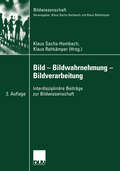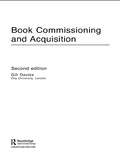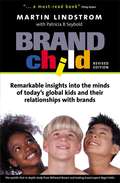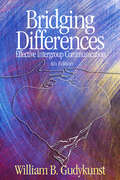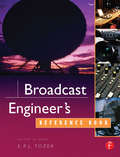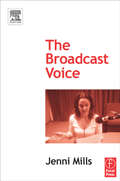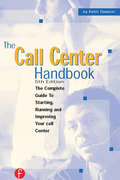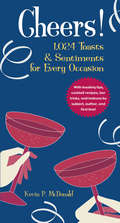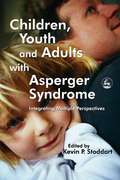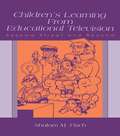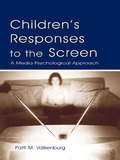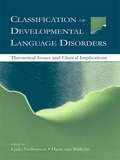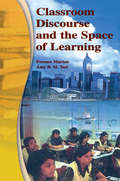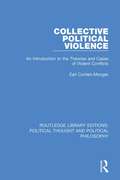- Table View
- List View
Bild — Bildwahrnehmung — Bildverarbeitung: Interdisziplinäre Beiträge zur Bildwissenschaft (Bildwissenschaft #15)
by Klaus Sachs-Hombach Klaus RehkämperBildgegebende Verfahren sind heute zu einem unverzichtbaren Bestandteil der technischen Konstruktion wie der wissenschaftlichen Analyse geworden, denn sie ermöglichen, komplexe Sachverhalte zu vereinfachen und zu strukturieren. Eine Bildwissenschaft hat sich aber bisher kaum ausgebildet. Klaus Sachs-Hombach und Klaus Rehkämper stellen die Ergebnisse einer interdisziplinären Zusammenarbeit vor, um das entstehen einer allgemeinen Bildwissenschaft zu fördern.
Book Commissioning and Acquisition
by Gill DaviesSince its first publication, this essential guide to book commissioning has established itself as the one and only 'must-read' for any successful editor, and the core training text used both within publishing houses and on publishing courses worldwide.In this new edition, Davies concentrates on the essential skills of commissioning, as well as other editorial challenges such as handling new lists following mergers and takeovers, and the demands of digital technology. New case-studies have been added which illustrate the commercial and practical problems that editors must address in today's complex and demanding marketplace.This book remains the one text that editors must have by their side throughout their careers.
Book Commissioning and Acquisition
by Gill DaviesSince its first publication, this essential guide to book commissioning has established itself as the one and only 'must-read' for any successful editor, and the core training text used both within publishing houses and on publishing courses worldwide.In this new edition, Davies concentrates on the essential skills of commissioning, as well as other editorial challenges such as handling new lists following mergers and takeovers, and the demands of digital technology. New case-studies have been added which illustrate the commercial and practical problems that editors must address in today's complex and demanding marketplace.This book remains the one text that editors must have by their side throughout their careers.
Brandchild: Remarkable Insights into the Minds of Today's Global Kids and Their Relationship with Brands (1st edition) (PDF)
by Martin Lindstrom Patricia SeyboldPraise and Reviews This is a must read book... Lindstrom provides fascinating stories taking you into the mental and emotional life of this new generation...- Philip Kotler, S C Johnson amp; Sons Distinguished Professor of International Marketing, Northwestern University, Kellogg School of ManagementBRANDchild will be a valuable addition to our industry's literature.- Lester Wunderman, Chairman Emeritus and founder of Wunderman Cato JohnsonLindstrom's fascinating tour-de-force may have you staying awake for 60 hours in order to mine the kids-focused marketing wisdom.- Stann Rapp, MRM Partners Worldwide and co-founder of Rapp CollinsTweens (8- to 14-year-olds) are an increasingly powerful and smart consumer group that spent $300 billion across the globe last year and influenced another $350 billion spend through their parents. Based on the world's most extensive study of tween attitudes and behaviours, and now available in paperback, BRANDchild is the first book to look in-depth at the phenomena behind global kids and their relationships with brands.Conducted by Millward Brown, the leading global market research agency, the BRANDchild survey involved several thousand kids from more than 70 cities in 14 countries (throughout Europe, Asia, the United States and South America). Several renowned experts share their unique views on kids' trends and fascinating marketing techniques.Packed with practical advice on how to create kids' brands, including more than 50 previously unpublished case studies, BRANDchild proposes innovative ways of marketing to this young audience.
Brandchild: Remarkable Insights into the Minds of Today's Global Kids and Their Relationship with Brands (1st edition) (PDF)
by Martin Lindstrom Patricia SeyboldPraise and Reviews This is a must read book... Lindstrom provides fascinating stories taking you into the mental and emotional life of this new generation...- Philip Kotler, S C Johnson amp; Sons Distinguished Professor of International Marketing, Northwestern University, Kellogg School of ManagementBRANDchild will be a valuable addition to our industry's literature.- Lester Wunderman, Chairman Emeritus and founder of Wunderman Cato JohnsonLindstrom's fascinating tour-de-force may have you staying awake for 60 hours in order to mine the kids-focused marketing wisdom.- Stann Rapp, MRM Partners Worldwide and co-founder of Rapp CollinsTweens (8- to 14-year-olds) are an increasingly powerful and smart consumer group that spent $300 billion across the globe last year and influenced another $350 billion spend through their parents. Based on the world's most extensive study of tween attitudes and behaviours, and now available in paperback, BRANDchild is the first book to look in-depth at the phenomena behind global kids and their relationships with brands.Conducted by Millward Brown, the leading global market research agency, the BRANDchild survey involved several thousand kids from more than 70 cities in 14 countries (throughout Europe, Asia, the United States and South America). Several renowned experts share their unique views on kids' trends and fascinating marketing techniques.Packed with practical advice on how to create kids' brands, including more than 50 previously unpublished case studies, BRANDchild proposes innovative ways of marketing to this young audience.
Bridging Differences: Effective Intergroup Communication
by William B. GudykunstThe Fourth Edition of Bridging Differences: Effective Intergroup Communication builds on the strengths of the previous editions and provides state-of-the-art knowledge about intergroup communication. This new edition brings a strong skills-oriented approach to improving communication effectiveness between people from different groups (e.g., cultures, ethnic groups, social classes). Bridging Differences is based on the assumption that the processes operating when we communicate with people from other groups are the same processes operating when we communicate with people from our own groups. Author William B. Gudykunst has written this book from the perspective of "communicating with strangers" and addresses how factors related to our group memberships (e.g., inaccurate and unfavorable stereotypes of members of other cultures and ethnic groups) can cause us to misinterpret the messages we receive from members of those groups. New to the Fourth Edition: Expanded discussions of several topics such as changing intergroup expectations; cultural differences in attribution processes; cultural and ethnic differences in conflict; cultural differences in indirect messages; cultural differences in uncertainty management; empathy; ethnic and cultural identities; face and its relationship to conflict management; intergroup communication effectiveness; intergroup conflict; intergroup biases; negotiating means; perceptual processes; and prejudice New material has been added on civic engagement; community in public life; diversity and community; the content of stereotypes; communication in romantic relationships; cultural differences in effective communication; and theoretical explanations for prejudice Pedagogical features include end-of-chapter study questions, self-assessment questionnaires, open-ended questions to stimulate readers to think about their implicit theories, and written skill exercises to increase students′ skill development Designed for students taking courses in Intercultural Communication or Intergroup Communication, Bridging Differences is also useful for many courses in Cultural Studies, Anthropology, Sociology, and Management.
Bridging Differences: Effective Intergroup Communication
by William B. GudykunstThe Fourth Edition of Bridging Differences: Effective Intergroup Communication builds on the strengths of the previous editions and provides state-of-the-art knowledge about intergroup communication. This new edition brings a strong skills-oriented approach to improving communication effectiveness between people from different groups (e.g., cultures, ethnic groups, social classes). Bridging Differences is based on the assumption that the processes operating when we communicate with people from other groups are the same processes operating when we communicate with people from our own groups. Author William B. Gudykunst has written this book from the perspective of "communicating with strangers" and addresses how factors related to our group memberships (e.g., inaccurate and unfavorable stereotypes of members of other cultures and ethnic groups) can cause us to misinterpret the messages we receive from members of those groups. New to the Fourth Edition: Expanded discussions of several topics such as changing intergroup expectations; cultural differences in attribution processes; cultural and ethnic differences in conflict; cultural differences in indirect messages; cultural differences in uncertainty management; empathy; ethnic and cultural identities; face and its relationship to conflict management; intergroup communication effectiveness; intergroup conflict; intergroup biases; negotiating means; perceptual processes; and prejudice New material has been added on civic engagement; community in public life; diversity and community; the content of stereotypes; communication in romantic relationships; cultural differences in effective communication; and theoretical explanations for prejudice Pedagogical features include end-of-chapter study questions, self-assessment questionnaires, open-ended questions to stimulate readers to think about their implicit theories, and written skill exercises to increase students′ skill development Designed for students taking courses in Intercultural Communication or Intergroup Communication, Bridging Differences is also useful for many courses in Cultural Studies, Anthropology, Sociology, and Management.
Broadcast Engineer's Reference Book
by E.P.J. TozerThe current and definitive reference broadcast engineers need!Compiled by leading international experts, this authoritative reference work covers every aspect of broadcast technology from camera to transmitter - encompassing subjects from analogue techniques to the latest digital compression and interactive technologies in a single source.Written with a minimum of maths, the book provides detailed coverage and quick access to key technologies, standards and practices. This global work will become your number one resource whether you are from an audio, video, communications or computing background. Composed for the industry professional, practicing engineer, technician or sales person looking for a guide that covers the broad landscape of television technology in one handy source, the Broadcast Engineer's Reference Book offers comprehensive and accurate technical information. Get this wealth of information at your fingertips!· Utilize extensive illustrations-more than 1200 tables, charts and photographs.· Find easy access to essential technical and standards data.· Discover information on every aspect of television technology.· Learn the concepts and terms every broadcaster needs to know.Learn from the experts on the following technologies:Quantities and Units; Error Correction; Network Technologies; Telco Technologies; Displays; Colourimetry; Audio Systems; Television Standards; Colour encoding; Time code; VBI data carriage; Broadcast Interconnect formats; File storage formats; HDTV; MPEG 2; DVB; Data Broadcast; ATSC Interactive TV; encryption systems; Optical systems; Studio Cameras and camcorders; VTRs and Tape Storage; Standards Convertors; TV Studios and Studio Equipment; Studio Lighting and Control; post production systems; Telecines; HDTV production systems; Media Asset Management systems; Electronic News Production Systems; OB vehicles and Mobile Control Rooms;ENG and EFP; Power and Battery Systems; R.F. propagation; Service Area Planning; Masts Towers and Antennas; Test and measurement; Systems management; and many more!Related Focal Press titles:Watkinson: Convergence In Broadcast and Communications Media (2001, £59.99 (GBP)/ $75.95 (USD), ISBN: 0240515099) Watkinson: MPEG Handbook (2001, £35 (GBP)/$54.99 (USD) ISBN: 0240516567)
Broadcast Engineer's Reference Book
by E. P. J. TozerThe current and definitive reference broadcast engineers need!Compiled by leading international experts, this authoritative reference work covers every aspect of broadcast technology from camera to transmitter - encompassing subjects from analogue techniques to the latest digital compression and interactive technologies in a single source.Written with a minimum of maths, the book provides detailed coverage and quick access to key technologies, standards and practices. This global work will become your number one resource whether you are from an audio, video, communications or computing background. Composed for the industry professional, practicing engineer, technician or sales person looking for a guide that covers the broad landscape of television technology in one handy source, the Broadcast Engineer's Reference Book offers comprehensive and accurate technical information. Get this wealth of information at your fingertips!· Utilize extensive illustrations-more than 1200 tables, charts and photographs.· Find easy access to essential technical and standards data.· Discover information on every aspect of television technology.· Learn the concepts and terms every broadcaster needs to know.Learn from the experts on the following technologies:Quantities and Units; Error Correction; Network Technologies; Telco Technologies; Displays; Colourimetry; Audio Systems; Television Standards; Colour encoding; Time code; VBI data carriage; Broadcast Interconnect formats; File storage formats; HDTV; MPEG 2; DVB; Data Broadcast; ATSC Interactive TV; encryption systems; Optical systems; Studio Cameras and camcorders; VTRs and Tape Storage; Standards Convertors; TV Studios and Studio Equipment; Studio Lighting and Control; post production systems; Telecines; HDTV production systems; Media Asset Management systems; Electronic News Production Systems; OB vehicles and Mobile Control Rooms;ENG and EFP; Power and Battery Systems; R.F. propagation; Service Area Planning; Masts Towers and Antennas; Test and measurement; Systems management; and many more!Related Focal Press titles:Watkinson: Convergence In Broadcast and Communications Media (2001, £59.99 (GBP)/ $75.95 (USD), ISBN: 0240515099) Watkinson: MPEG Handbook (2001, £35 (GBP)/$54.99 (USD) ISBN: 0240516567)
The Broadcast Voice
by Jenni MillsAnyone working - or aspiring to work - as a radio or TV presenter will benefit from Jenni Mills' experience. This inspirational book and tutorial-packed CD provide unique access to the advice previously only available through her one-on-one coaching sessions. Jenni teaches how to get the best from your voice in front of the microphone through techniques and exercises designed specifically for broadcasting. She covers both the physical aspects of voice production and the mind-set needed to broadcast with authority and warmth. Audio and video clips on the accompanying CD-Rom illustrate the dos and don'ts discussed in the book as well as demonstrating voice exercises.
The Broadcast Voice
by Jenni MillsAnyone working - or aspiring to work - as a radio or TV presenter will benefit from Jenni Mills' experience. This inspirational book and tutorial-packed CD provide unique access to the advice previously only available through her one-on-one coaching sessions. Jenni teaches how to get the best from your voice in front of the microphone through techniques and exercises designed specifically for broadcasting. She covers both the physical aspects of voice production and the mind-set needed to broadcast with authority and warmth. Audio and video clips on the accompanying CD-Rom illustrate the dos and don'ts discussed in the book as well as demonstrating voice exercises.
The Call Center Handbook: The Complete Guide to Starting, Running, and Improving Your Call Center
by Keith DawsonNeed to know how to buy a phone switch for your call center? How to measure the productivity of agents? How to choose from two cities that both want your center? No problem. The Call Center Handbook is a complete guide to starting, running, and im
Cheers!: 1,024 Toasts & Sentiments for Every Occasion
by Kevin P. McDonaldCheers! is an indispensable A-to-Z of warm, funny, erudite, and sentimental sayings forevery possible occasion. Organized by category, Cheers! is more than a list of notable quotes and memorable toasts. It is full of useful advice on how to prepare a personalized message using the sayings in the book; deliver a toast without becoming flustered or, worse, running too long; and determine what words are appropriate for any given situation. An extended index and cross-references make Cheers! extremely easy to navigate, so finding the perfect words is a cinch.
Children, Youth and Adults with Asperger Syndrome: Integrating Multiple Perspectives (PDF)
by Kevin StoddartThis book offers a comprehensive overview of clinical, research and personal perspectives on Asperger Syndrome, including contributions from parents and experts in the fields of psychology, social work, psychiatry, genetics, sexology and vocational counselling. It includes first-hand accounts from adults with AS, highlighting their difficulties in areas such as social competence and education. Specialist perspectives on AS, including sexuality and relationships, finding and keeping employment and anxiety and depression are sensitively addressed. The viewpoints of parents explore experiences of parenting AS individuals. These varied approaches to living with AS complement the emerging literature on theory, research and practice in this area. The broad scope of Children, Youth and Adults with Asperger Syndrome guarantees a wide readership among practitioners, students, parents, young people and adults with AS, educates service providers how to assist people with AS and suggests a model of interdisciplinary collaboration for administrators and funders.
Children's Learning From Educational Television: Sesame Street and Beyond
by Shalom M. FischAt its best, educational television can provide children with enormous opportunities and can serve as a window to new experiences, enrich academic knowledge, enhance attitudes and motivation, and nurture social skills. This volume documents the impact of educational television in a variety of subject areas and proposes mechanisms to explain its effects. Drawing from a wide variety of research spanning several disciplines, author Shalom M. Fisch analyzes the literature on the impact of educational resources. He focuses on television programs designed for children rather than for adults, although adult literature is included when it is particularly relevant. In addition, much of the discussion concerns the effects of unaided viewing by children, rather than viewing in the context of adult-led follow-up activities. The role of parent-child co-viewing and issues relevant to the use of television in school or child care also receives consideration. This volume is intended to make the disparate literature on educational television's impact more accessible, by bringing it together into a centralized resource. To that end, the volume draws together empirical data on the impact of educational television programs--both academic and prosocial--on children's knowledge, skills, attitudes, and behavior. In addition to its emphasis on positive effects, this volume addresses a gap in the existing research literature regarding children's learning from exposure to educational television. Acknowledging that little theoretical work has been done to explain why or how these effects occur, Fisch takes a step toward correcting this situation by proposing theoretical models to explore aspects of the mental processing that underlies children's learning from educational television. With its unique perspective on children's educational television and comprehensive approach to studying the topic, this volume is required reading for scholars, researchers, and students working in the area of children and television. It offers crucial insights to scholars in developmental psychology, family studies, educational psychology, and related areas.
Children's Learning From Educational Television: Sesame Street and Beyond
by Shalom M. FischAt its best, educational television can provide children with enormous opportunities and can serve as a window to new experiences, enrich academic knowledge, enhance attitudes and motivation, and nurture social skills. This volume documents the impact of educational television in a variety of subject areas and proposes mechanisms to explain its effects. Drawing from a wide variety of research spanning several disciplines, author Shalom M. Fisch analyzes the literature on the impact of educational resources. He focuses on television programs designed for children rather than for adults, although adult literature is included when it is particularly relevant. In addition, much of the discussion concerns the effects of unaided viewing by children, rather than viewing in the context of adult-led follow-up activities. The role of parent-child co-viewing and issues relevant to the use of television in school or child care also receives consideration. This volume is intended to make the disparate literature on educational television's impact more accessible, by bringing it together into a centralized resource. To that end, the volume draws together empirical data on the impact of educational television programs--both academic and prosocial--on children's knowledge, skills, attitudes, and behavior. In addition to its emphasis on positive effects, this volume addresses a gap in the existing research literature regarding children's learning from exposure to educational television. Acknowledging that little theoretical work has been done to explain why or how these effects occur, Fisch takes a step toward correcting this situation by proposing theoretical models to explore aspects of the mental processing that underlies children's learning from educational television. With its unique perspective on children's educational television and comprehensive approach to studying the topic, this volume is required reading for scholars, researchers, and students working in the area of children and television. It offers crucial insights to scholars in developmental psychology, family studies, educational psychology, and related areas.
Children's Responses to the Screen: A Media Psychological Approach (Routledge Communication Series)
by Patti M. ValkenburgThe past several decades have witnessed thousands of studies into children and the media. Yet, much academic research is still in its infancy when it comes to our knowledge about the uses, preferences, and effects of different media. This distinctive volume moves the field forward in this regard, with its insights into the latest theories and research on children and the media. Author Patti M. Valkenburg explores "screen" media (i.e., television, films, video and computer games, and the Internet), and focuses her study on the most fundamental topics in the study of children and the media. In each chapter, Valkenburg examines an essential topic on children and the media: the effect of media violence, children's emotional reactions to news and entertainment, the intended and unintended effects of advertising, and the uses and effects of computer games and the Internet. She has structured the chapters to provide an overview of existing theories and research on a particular topic, and supplements the work of others with her own ground-breaking research findings. She provides a careful and even-handed treatment of research in children's media, and includes current and noteworthy studies. As a resource for study in children and media and media psychology, this volume provides a timely and thorough examination of the state of theory and research. It will serve as a valuable reference for scholars and as an engaging text for advanced students.
Children's Responses to the Screen: A Media Psychological Approach (Routledge Communication Series)
by Patti M. ValkenburgThe past several decades have witnessed thousands of studies into children and the media. Yet, much academic research is still in its infancy when it comes to our knowledge about the uses, preferences, and effects of different media. This distinctive volume moves the field forward in this regard, with its insights into the latest theories and research on children and the media. Author Patti M. Valkenburg explores "screen" media (i.e., television, films, video and computer games, and the Internet), and focuses her study on the most fundamental topics in the study of children and the media. In each chapter, Valkenburg examines an essential topic on children and the media: the effect of media violence, children's emotional reactions to news and entertainment, the intended and unintended effects of advertising, and the uses and effects of computer games and the Internet. She has structured the chapters to provide an overview of existing theories and research on a particular topic, and supplements the work of others with her own ground-breaking research findings. She provides a careful and even-handed treatment of research in children's media, and includes current and noteworthy studies. As a resource for study in children and media and media psychology, this volume provides a timely and thorough examination of the state of theory and research. It will serve as a valuable reference for scholars and as an engaging text for advanced students.
Classification of Developmental Language Disorders: Theoretical Issues and Clinical Implications
by Ludo Verhoeven Hans Van BalkomChapters written by leading authorities offer current perspectives on the origins and development of language disorders. They address the question: How can the child's linguistic environment be restructured so that children at risk can develop important adaptive skills in the domains of self-care, social interaction, and problem solving? This theory-based, but practical book emphasizes the importance of accurate definitions of subtypes for assessment and intervention. It will be of interest to students, researchers, and practitioners in the field of developmental language disorders.
Classification of Developmental Language Disorders: Theoretical Issues and Clinical Implications
by Ludo Verhoeven Hans Van BalkomChapters written by leading authorities offer current perspectives on the origins and development of language disorders. They address the question: How can the child's linguistic environment be restructured so that children at risk can develop important adaptive skills in the domains of self-care, social interaction, and problem solving? This theory-based, but practical book emphasizes the importance of accurate definitions of subtypes for assessment and intervention. It will be of interest to students, researchers, and practitioners in the field of developmental language disorders.
Classroom Discourse and the Space of Learning
by Ference Marton Amy B.M. Tsui Pakey P.M. Chik Po Yuk Ko Mun Ling LoClassroom Discourse and the Space of Learning is about learning in schools and the central role of language in learning. The investigations of learning it reports are based on two premises: First, whatever you are trying to learn, there are certain necessary conditions for succeeding--although you cannot be sure that learning will take place when those conditions are met, you can be sure that no learning will occur if they are not. The limits of what is possible to learn is what the authors call "the space of learning." Second, language plays a central role in learning--it does not merely convey meaning, it also creates meaning. The book explicates the necessary conditions for successful learning and employs investigations of classroom discourse data to demonstrate how the space of learning is linguistically constituted in the classroom.Classroom Discourse and the Space of Learning:*makes the case that an understanding of how the space of learning is linguistically constituted in the classroom is best achieved through investigating "classroom discourse" and that finding out what the conditions are for successful learning and bringing them about should be the teacher's primary professional task. Thus, it is fundamentally important for teachers and student teachers to be given opportunities to observe different teachers teaching the same thing, and to analyze and reflect on whether the classroom discourse in which they are engaged maximizes or minimizes the conditions for learning;*is both more culturally situated and more generalizable than many other studies of learning in schools. Each case of classroom teaching clearly demonstrates how the specific language, culture, and pedagogy molds what is happening in the classroom, yet at the same time it is possible to generalize from these culturally specific examples the necessary conditions that must be met for the development of any specific capability regardless of where the learning is taking place and what other conditions might be present; and *encompasses both theory and practice--providing a detailed explication of the theory of learning underlying the analyses of classroom teaching reported, along with close analyses of a number of authentic cases of classroom teaching driven by classroom discourse data which have practical relevance for teachers.Intended for researchers and graduate students in education, teacher educators, and student teachers, Classroom Discourse and the Space of Learning is practice- and content-oriented, theoretical, qualitative, empirical, and focused on language, and links teaching and learning in significant new ways.
Classroom Discourse and the Space of Learning
by Ference Marton Amy B.M. Tsui Pakey P.M. Chik Po Yuk Ko Mun Ling LoClassroom Discourse and the Space of Learning is about learning in schools and the central role of language in learning. The investigations of learning it reports are based on two premises: First, whatever you are trying to learn, there are certain necessary conditions for succeeding--although you cannot be sure that learning will take place when those conditions are met, you can be sure that no learning will occur if they are not. The limits of what is possible to learn is what the authors call "the space of learning." Second, language plays a central role in learning--it does not merely convey meaning, it also creates meaning. The book explicates the necessary conditions for successful learning and employs investigations of classroom discourse data to demonstrate how the space of learning is linguistically constituted in the classroom.Classroom Discourse and the Space of Learning:*makes the case that an understanding of how the space of learning is linguistically constituted in the classroom is best achieved through investigating "classroom discourse" and that finding out what the conditions are for successful learning and bringing them about should be the teacher's primary professional task. Thus, it is fundamentally important for teachers and student teachers to be given opportunities to observe different teachers teaching the same thing, and to analyze and reflect on whether the classroom discourse in which they are engaged maximizes or minimizes the conditions for learning;*is both more culturally situated and more generalizable than many other studies of learning in schools. Each case of classroom teaching clearly demonstrates how the specific language, culture, and pedagogy molds what is happening in the classroom, yet at the same time it is possible to generalize from these culturally specific examples the necessary conditions that must be met for the development of any specific capability regardless of where the learning is taking place and what other conditions might be present; and *encompasses both theory and practice--providing a detailed explication of the theory of learning underlying the analyses of classroom teaching reported, along with close analyses of a number of authentic cases of classroom teaching driven by classroom discourse data which have practical relevance for teachers.Intended for researchers and graduate students in education, teacher educators, and student teachers, Classroom Discourse and the Space of Learning is practice- and content-oriented, theoretical, qualitative, empirical, and focused on language, and links teaching and learning in significant new ways.
Collective Political Violence: An Introduction to the Theories and Cases of Violent Conflicts (Routledge Library Editions: Political Thought and Political Philosophy #16)
by Earl Conteh-MorganFirst published in 2004. Collective Political Violence is a concise, but thorough, interdisciplinary analysis of the many competing concepts, theories, and explanations of political conflict, including revolutions, civil wars, genocide, and terrorism. To further his examination of each type of conflict, Earl Conteh-Morgan presents case studies, from the Rwandan genocide to the civil rights movement in the United States. Along the way, he illuminates new debates concerning terrorism, peacekeeping, and environmental security. Written in a knowledgeable, yet accessible, manner, Collective Political Violence treats the issue of political violence with on impressively wide geographic range, and successfully straddles the ideological divide.
Collective Political Violence: An Introduction to the Theories and Cases of Violent Conflicts (Routledge Library Editions: Political Thought and Political Philosophy #16)
by Earl Conteh-MorganFirst published in 2004. Collective Political Violence is a concise, but thorough, interdisciplinary analysis of the many competing concepts, theories, and explanations of political conflict, including revolutions, civil wars, genocide, and terrorism. To further his examination of each type of conflict, Earl Conteh-Morgan presents case studies, from the Rwandan genocide to the civil rights movement in the United States. Along the way, he illuminates new debates concerning terrorism, peacekeeping, and environmental security. Written in a knowledgeable, yet accessible, manner, Collective Political Violence treats the issue of political violence with on impressively wide geographic range, and successfully straddles the ideological divide.
Colloquial Hebrew
by Zippi Lyttleton Tamar WangColloquial Hebrew provides a step-by-step course in Hebrew as it is written and spoken today. Combining a user-friendly approach with a thorough treatment of the language, it equips learners with the essential skills needed to communicate confidently and effectively in Hebrew in a broad range of situations. No prior knowledge of the language is required. Key features include: • progressive coverage of speaking, listening, reading and writing skills • structured, jargon-free explanations of grammar • an extensive range of focused and stimulating exercises • realistic and entertaining dialogues covering a broad variety of scenarios • useful vocabulary lists throughout the text • additional resources available at the back of the book, including a full answer key, a grammar summary and bilingual glossaries Balanced, comprehensive and rewarding, Colloquial Hebrew will be an indispensable resource both for independent learners and students taking courses in Hebrew. Audio material to accompany the course is available to download freely in MP3 format from www.routledge.com/cw/colloquials. Recorded by native speakers, the audio material features the dialogues and texts from the book and will help develop your listening and pronunciation skills.
